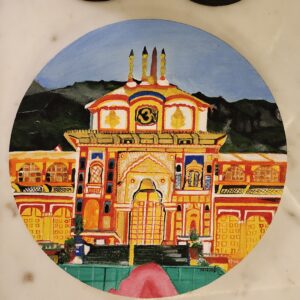Bhagwat Geeta Oil Painting
The 700-verse Hindu text known as the Bhagavad Gita, or just the Gita, is a component of the Mahabharata, an epic story from India. This is a dialogue between Prince Arjuna and his charioteer, the god Krishna. Set on the battlefield of Kurukshetra shortly before a major conflict, the poem delves deeply into theological and philosophical questions.
The period of composition for the Bhagavad Gita was 400 BCE to 200 CE. It is included in the Mahabharata, a lengthy story that describes the conflict between the Pandavas and the Kauravas, two families of relatives, for the title of Hastinapura. The Gita is presented as a conversation between the warrior and royal Arjuna and his charioteer, Krishna, who is an incarnation of the divinity Vishnu. The exchange takes place in the midst of Arjuna’s moral uncertainty and doubts about engaging in the war.
The Gita is composed of eighteen chapters, each of which covers a distinct facet of spirituality, life, and obligation. Three sections can be used to roughly group the chapters:
Karma Yoga, also known as The Yoga of Action, is the study of obligation and selfless action (dharma). Krishna counsels Arjuna to carry out his warrior duty without concern about the outcome. The foundation of Karma Yoga is the idea of carrying out one’s job without thinking about the result.
Bhakti Yoga, often known as “The Yoga of Devotion,” places a strong emphasis on turning to God in order to find emancipation. Krishna emphasizes the value of loving and submitting to God by showing Arjuna his heavenly appearance.
The quest of spiritual wisdom and knowledge is the main topic of this portion of Jnana Yoga, also known as The Yoga of Knowledge. It talks about the nature of Atman, the self, and how it relates to both the material world and Brahman, the ultimate reality.
Philosophical Themes
The Gita delves into the idea of dharma, which is responsibility and righteousness. Arjuna’s first hesitancy to engage in combat stems from his unclear sense of duty. Krishna’s teachings place a strong emphasis on carrying out one’s duties in accordance with one’s life function, but without regard to one’s own interests.
Selflessness and Detachment: The idea of acting without regard to the results of one’s actions is a central element. This is what Karma Yoga is all about. People can grow spiritually and stay calm by concentrating on the deed itself instead of the results.
The Gita makes a distinction between the everlasting soul (Atman) and the physical body when discussing the nature of the self. It is said that the soul is unbreakable and that it reincarnates itself many times before reaching emancipation (moksha).
Devotion and Divine Grace: Krishna teaches Bhakti Yoga students that the paths to freedom are devotion and submission to God. This devotion might go beyond conventions and beliefs, emphasizing a one-on-one contact with God.
Cosmic Vision: Krishna shows Arjuna his universal form, or Vishvarupa, illustrating both his heavenly might and the interdependence of all things. Arjuna gains insight into the impermanence of life and the omnipresence of the divine from this vision.
The Gita talks about Arjuna’s moral conundrum, wherein he must choose between his sympathy for his friends and family who are on the other side and his obligation as a warrior. Krishna’s teachings offer a framework for settling these disputes by emphasizing higher ideals and the bigger picture effects of one’s deeds.
History and Significance
Hinduism and philosophy have been greatly influenced by the Bhagavad Gita. varied Hindu philosophical traditions have given varied interpretations to its teachings. It has also had an influence on world leaders and intellectuals, like Mahatma Gandhi, who took inspiration from the Gita for his ideas on nonviolence and selfless deeds.
Current Significance
The Gita’s lessons on responsibility, moral conduct, and pursuing spiritual development are still relevant today for anyone looking for direction in both their personal and professional lives. Its emphasis on carrying out one’s responsibilities with honesty and without regard to the outcome provides a timeless lesson in overcoming obstacles in life.
The Bhagavad Gita is an enduring spiritual text that tackles the intricacies of existence and the pursuit of significance. It is a pillar of Indian philosophy and an inspiration to people everywhere because it provides a way to achieve spiritual realization and inner serenity through its teachings on responsibility, devotion, and knowledge.








Reviews
There are no reviews yet.